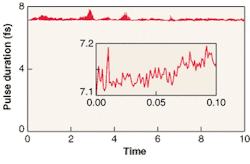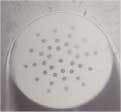Newsbreaks
Semiconductor omnidirectional reflector can integrate with photonic devices
Although often described in terms of one-dimensional photonic crystals, an omnidirectional thin-film reflector is, in less high-flying optical terms, simply a multilayer coating whose angular high-reflectivity range for a certain wavelength band extends from normal to 90º incidence. Researchers at Seoul National University (Seoul, Korea) have now fabricated such a reflector from compound semiconductor materials. The molecular-beam epitaxy fabrication process has the advantage of high reproducibility; in addition, the semiconductor coating is easily fabricated on the same substrate with lasers and photodiodes.
Four pairs of gallium arsenide/aluminum arsenide (GaAs/AlAs) layers were grown, then the AlAs layers converted to aluminum oxide by wet thermal oxidation. The nominal thicknesses of the layers were 65 and 145 nm for GaAs and AlAs-oxide, respectively. The experimentally observed omnidirectional-reflection range for TM-polarized light was restricted to a narrow band centered on 900 nm; for TE-polarized light, the range extended from 900 to greater than 1100 nm. High reflectance was degraded below 850 nm because GaAs becomes absorptive for those shorter wavelengths. Contact Heonsu Jeon at [email protected].
Lens-free optics simplify transient-grating heterodyne detection
The transient grating method of optical detection can be used by materials scientists to measure molecular and lattice vibrations, acoustic waves, heat or molecular diffusion, and other phenomena of interest. In this heterodyne method, pump and probe laser beams are each divided in two by a common phase mask. The pump beams interfere to form a grating within the sample of interest; the probe beam is diffracted within the sample and the resulting intensity monitored to determine the relevant physical data. But the precise optical alignment requirements of the apparatus have in the past precluded widespread use of the method.
Researchers at the University of Tokyo have developed a simplified transient-grating technique that should allow easier setup. In the lensless system, pump and probe beams are combined by a dichroic mirror; they both strike a transmission grating that creates two beams for interference within the sample. The probe beam is diffracted by both the transmission and transient gratings; both diffracted beams are detected together. The researchers tested the technique on a 30-nm-thick gold film, as well as dyes in an optical cell, with good results. Contact Kenji Katayama at [email protected].
SPIDER characterizes single-shot ultrafast pulses at kilohertz rates
Researchers at the Swiss Federal Institute of Technology (Zurich, Switzerland) and the Istituto Nazionale per la Fisica della Materia (Milan, Italy) have developed a method for single-shot characterization of few-cycle ultrafast optical pulses that works up to kilohertz rates. Based on spectral phase interferometry for direct electric-field reconstruction (SPIDER), the technique improves on the pulse-measurement rate of other SPIDER and non-SPIDER techniques by a factor of greater than 50.
Two spectrometers were used, one for the fundamental spectrum and the other for the SPIDER interferogram. Each had a 2048-pixel dynamically triggerable line-scan charge-coupled-device camera; both cameras were triggered at once from the laser system. The spectrometers had 150- and 600-line/mm gratings that resolved 0.5 nm at 800 nm and 0.1 nm at 400 nm respectively. For test, an acousto-optic programmable filter generated an alternating spectral hole that was clearly resolved by the measurement system. Data include a time-series plot of 10,000 pulses of the duration of pulses (with an inset for the first 100 shots on a magnified vertical scale) from a Ti:sapphire amplifier compressed in a hollow argon-filled fiber. Contact Wouter Kornelis at [email protected].
Magnetic field boosts terahertz radiation from indium antimonide
Semiconductors irradiated with ultrafast optical pulses can function as sources of terahertz radiation. Research has shown that magnetic fields can enhance the output of such sources. Gallium arsenide and indium arsenide (InAs) both emit terahertz radiation more strongly when bathed in a magnetic field. Now, researchers at the Graduate University for Advanced Studies (Hayama, Japan), the Institute for Molecular Science (Okazaki, Japan) and Aisen Seiki Co. (Kariya, Japan) have exploited the properties of indium antimonide (InSb), which has a much smaller effective electron mass than that of InAs, to generate an even stronger magnetically induced boost in terahertz output.
A modelocked fiber laser delivers 100-fs polarized pulses at 1560 or 780 nm to an undoped bulk InSb (100) sample. A split-coil superconducting magnet produces a field of up to 5 T at the sample, applied parallel to the sample surface and perpendicular to the incidence plane of the fiber laser. At 1560 nm, the terahertz output of the InSb increases by a factor of ten as the field rises to 1 T, then drops, then rises again as the field approaches 5 T. At 780 nm the output has similar characteristics except that it is an order of magnitude lower. Contact Hiroshi Takahashi at [email protected].
Integrated field-effect transistor modulates light
Furthering the prospect of all-silicon (Si) optoelectronic integrated circuits, researchers at the University of Catania, the CNR-IMM sezione di Catania, and STMicroelectronics (all of Catania, Italy) and the CNR-IMM sezione di Napoli (Napoli, Italy) have developed an Si-based light modulator consisting of a three-terminal bipolar-mode field-effect transistor integrated with a 10-µm-wide Si rib waveguide on a Si wafer. The modulator's optical channel is contained within a vertical electrical channel.
To modulate light, a bias is applied to the control electrode, moving a plasma of carriers either into or out of the optical channel. When they are in the channel, the Si absorbs more light. Emission microscopy images reveals the plasma distribution within the device for different biases (the plasma itself causes some emission of light, making its form visible). Computer simulations agree with the experimental observation that modulation is achieved by injecting a 10-mA current and switching the drain voltage from its –10-V off state to its +10-V on state. A modulation depth of 75% has been achieved. An optimized structure with changes such as smaller gate contacts is under development. Contact Antonella Sciuto at [email protected].
Fresnel fiber conducts light down central air hole
Researchers at the University of Sydney (Sydney, Australia) have developed a holey optical fiber that conducts light along a central air channel, but that operates on a principle different from that of photonic-crystal (PC) fibers. While PC fibers have periodic arrays of holes designed to create Bragg reflection, confining light within a central air-filled or solid channel, the University of Sydney fiber has air holes distributed along the fiber's effective Fresnel zones, such as in the 125-µm-diameter fiber shown here. Light scattering from the surfaces of the air holes interferes constructively, producing a peak field intensity at the center of the fiber. Such a fiber has less-stringent manufacturing tolerances than does a PC fiber.
The air holes, separated by 8 to 12 µm, were placed in Fresnel zones designed to produce a 30-µm mode-field diameter. The hole size for an experimental Fresnel fiber was found empirically from a selection of samples with different-sized holes. Light of 633, 1052, or 1550 nm was sent down a 20-cm-long fiber. Much light leaked between the holes at 633 nm, and less at 1052 nm (with an offset central peak, the shift due to an offset central fiber hole). At 1550 nm, the mode profile was centered in the core hole. Contact John Canning at [email protected].
Photonic crystals may become magnetic emitters
Researchers at the Massachusetts Institute of technology (MIT; Cambridge, MA) are investigating the possibility of creating three-dimensional photonic crystals (PCs) that act as magnetic "metamaterials" that, though made of nonmagnetic material, become magnetic due to their structure. Such PCs would contain defects that would be optically excited, perhaps enhanced by incorporating fluorescent dyes into the PC; the dyes would emit at the wavelength of the defect's mode.
Properly designed, a point defect could produce a local field pattern that mimics an oscillating magnetic moment. Through analysis, the MIT researchers showed that more than 98% of the PC's emitted power would become magnetic multipole radiation. The metamaterial's properties would allow it to operate at frequencies corresponding to wave vectors at the edge of the Brillouin zone, resulting in ferromagnetic or antiferromagnetic PC arrays. Complexes of defects within a certain layer of the crystal would also produce ferro- or antiferromagnetic properties. Increasing the lateral size of the crystal increases the effect, while increasing the vertical size decreases the effect. Contact Michelle Povinelli at [email protected].
Solid-state-lighting fixture stays cool
A lighting fixture introduced at Lightfair International (May 6–8; New York, NY) by OptoLum (New York, NY) is one of the first to exploit the high white-light output of the Luxeon light-emitting diodes (LEDs) developed by Lumileds (San Jose, CA). The Luxeon emitters, which each contain an LED chip mounted on a heat sink and encapsulated in silicone, are the brightest commercially available single-chip white-light LEDs and have a 50,000-h median life (see Laser Focus World, September 2002, p. 17). The fixture developed at OptoLum contains 24 1.2-W LEDs and emits 800 lumens (about as much as a 60-W incandescent bulb) into a full 360° angular range.
One key to reliable operation of such a tight cluster of high-power LEDs is adequate heat removal, says Joel Dry, president of OptoLum. The company's engineers created a design in which the LEDs are mounted to the exterior of a cylindrical heat chimney through which air is drawn by a small fan. The fixture is envisioned for use in difficult-to access locations, and on cruise ships and passenger aircraft. Contact Joel Dry at [email protected]
Cesium triborate provides efficient frequency-tripling
High-quality crystals of cesium triborate (CsB3O5, or CBO) have been grown by researchers at Osaka University (Osaka, Japan) for use in generating 355-nm light as the sum frequency of 1064-nm fundamental and 532-nm second-harmonic light from an Nd:YAG or similar laser. Grown by the top-seeded-solution technique, the crystals have a short-absorption edge at 170 nm, enabling deep-ultraviolet generation to 200 nm as well.
An experimental setup for 355-nm generation with an 8-mm-long type-II CBO crystal used a diode-pumped Nd:YVO4 (vanadate) laser with pulse repetition rates from 21 to 100 kHz as a fundamental light source. The TEM00 pulses had a 10-ns duration; average power ranged to 11.3 W. A lithium triborate crystal (LBO) provided second-harmonic light. The researchers obtained 3.0 W of 355-nm light from an input fundamental power of 10.2 W, or a 30% efficiency. In comparison, an LBO crystal used for 355-nm generation in place of the CBO was only 19% efficient in the conversion. A second CBO crystal made by an older, inferior fabrication technique was only 25% efficient and deteriorated due to high absorption. Contact Yusuke Mori at [email protected].



